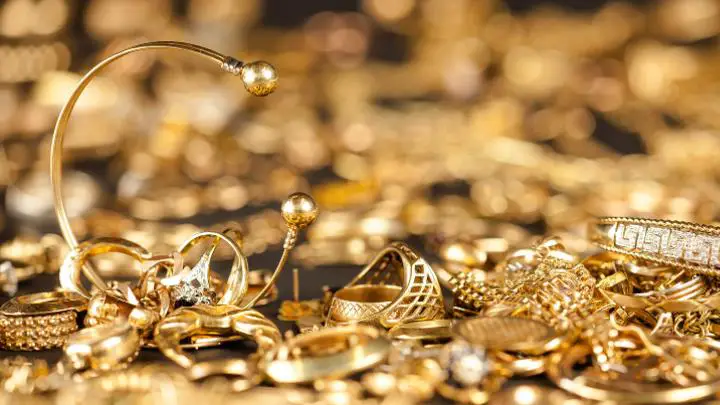Gold plated vs gold filled
There are a lot of terms that get thrown around at jewelry stores, and they can be confusing to the average consumer.
For example, gold-plated vs gold-filled; what do these two mean, what are the differences between gold-plated vs gold-filled? Are you getting ripped off by overpaying for gold-plated jewelry when you thought you were getting gold-filled jewelry?
This article explains the answers to these questions so that you can make better buying decisions when shopping for jewelry online or in person.
What Is Gold Plated?
Gold plated is made by using electricity or chemicals to deposit and bond a very thin layer of gold over another metal, usually silver or copper. Manufacturers often use it on costume jewelry and other less expensive pieces.
Manufacturers usually mark gold-plated jewelry as “GP” (gold plated), “RGP” (rolled gold plated), or “HGE” (heavy gold electroplate). These markings indicate that the manufacturer plate the base metal with a layer of gold using an electroplating or chemical-based process.
When shopping for gold-plated jewelry, you need to consider how thick the gold layer is. If the gold layer is too thin, the jewelry can easily wear through and expose the base metal underneath.
What Is Gold Filled?
Gold-filled is a solid layer of gold bonded to a supporting metal. Manufacturers make gold-filled jewelry by heat and pressure bonding a layer of gold to another metal, such as brass.
This process creates a durable outer layer that is much thicker than gold-plated metals and will not rub or wear off.
The US government requires that gold-filled pieces have a minimum layer of 10K gold on the surface of the base metal. This layer must be at least 1/20 of the total weight of the piece (not including stones).
For example, a 16-inch gold-filled necklace that weighs 5 grams must have at least 1 gram (1000 milligrams) of 10K gold in the layer on the outside (1/20 = 5%).
Gold-filled jewelry is beautiful, durable, safe, and affordable. This type of jewelry will last years without tarnishing, making it more valuable for those who wear it regularly.
SEE: How to Clean Gold Plated Jewelry (Without Ruining It)
Gold Plated vs Gold Filled
Gold plated jewelry involves applying a thin layer of gold over another metal, usually silver or brass. The thickness of the layer of gold can vary depending on what it takes to cover the base metal and make it look good.
Gold-filled jewelry, on the other hand, involves using pressure or heat to mechanically bind gold to a base metal such as brass. Gold plated has a very thin layer of gold (usually 0.5 microns thick) on the surface, while gold-filled has a much thicker layer of gold (up to 50 microns thick) on the surface.
Because gold-filled jewelry contains a much larger amount of gold, it is much more durable than gold-plated jewelry. It can last for decades, so you can wear your pieces daily without worrying that they will tarnish or fade.
Gold-filled pieces are also less likely to cause a skin reaction, making them perfect for people with sensitive types. You can even shower in them.
Gold-plated jewelry, on the other hand, is susceptible to peeling and tarnishing if not properly cared for. This leaves your skin exposed to the potentially irritating base metals below, increasing your chances of skin reaction.
Which One Should You Use?
If you are looking for an inexpensive but luxurious-looking piece of jewelry, gold plated is a good choice. The main benefit of buying gold-plated jewelry is cost savings, as it costs much less than gold-filled jewelry.
However, the downside to buying gold-plated jewelry is that it doesn’t last long due to its lack of durability.
If you’re looking for something that’s going to last, gold-filled is a much better choice. It contains 100+ times more real gold than gold-plated items. Even with daily wear, it can last up to 30 years and won’t change color or tarnish.
SEE: How Long Does Gold-Plated Jewelry Last? Tips on How to Care For Your Jewelry
How Do You Know if a Jewelry Is Gold Plated or Gold Filled?
There are a few different ways to figure out if your jewelry is gold-plated or gold-filled.
One way is to look at the jewelry itself and check for any markings. Manufacturers stamp gold-plated pieces with GP and gold-filled pieces with 10/20 GF or something similar. For example, 14/20 GF, means that the item contains 14K gold and 20% of the item’s weight is gold.
You can also perform a scratch test by scratching the jewelry with a knife or any other sharp object. If it leaves a golden mark on the object, it is gold-plated. If your piece is gold-filled, no mark will appear.
Is Gold Vermeil the Same Thing as Gold Plated?
No, gold vermeil and gold plated are not the same. Gold vermeil is a thick layer of pure gold over sterling silver. The piece must be at least 10-karat gold and must be 2.5 microns thick.
Gold vermeil pieces are perfect for people with metal allergies or sensitivities, as there is no base metal in contact with the skin.
Gold plated, on the other hand, is a thin layer of gold over another metal, usually copper, brass, or steel. There are no karat requirements for gold-plated pieces, and they can irritate people with metal allergies or sensitivities because of the underlying base metal.
Another difference between vermeil and plated pieces is in their value. Vermeil retains its value because it consists of sterling silver, whereas gold-plated value depends on its base metal alone.
Gold vermeil is also more expensive than gold-plated pieces because of its thicker gold coating and because sterling silver is more expensive than base metals. However, because vermeil’s layer of gold lasts longer, it will save you money in the long run.
SEE: Is Gold Plated Real Gold? What Exactly Is the Difference?
Types of Base Metals in Jewelry
You can find a wide variety of base metals in jewelry, but these are the most common:
Silver
Silver is one of the most popular base metals in jewelry making because it is soft and easy to work with. However, most manufacturers mix silver with another base metal to make it harder and more durable.
Aluminum
Aluminum is another popular base metal because it is lightweight and strong. However, it loses its shine easily. Manufacturers use aluminum to make different types of jewelry because it’s inexpensive.
Copper
People have been using copper to make jewelry since ancient times because it is inexpensive and easy to work with. Like aluminum, it also tarnishes quickly and can turn skin green with exposure to moisture and perspiration.
Nickel
Nickel is one of the most popular base metals in jewelry and people have been using it for a long time. Manufacturers also mix it with silver to make nickel-silver, which is a strong alloy and a cheaper alternative to sterling silver.
Brass
Brass is a combination of copper and zinc and people have been using it for more than 5,000 years. The greater the zinc content, the harder the brass becomes. Because of its durability and shiny appearance, it is a popular metal in jewelry making.
Bronze
Bronze is a copper and tin alloy; it has a golden color that turns green or brown after oxidation. Unlike aluminum and copper, bronze does not tarnish easily and can make jewelry last longer.
SEE: Find From Simple to Grand Evergreen Gift Ideas for Women
FAQs
Does gold-plated jewelry turn green?
Yes, it does. Gold-plated jewelry can develop a green tint over time. One common cause of this reaction is high levels of acidity in your skin, which can erode the thin layer of gold plating and expose parts of the base metal underneath.
Why should you choose gold-filled over gold-plated?
Gold-filled jewelry lasts longer than gold-plated jewelry because of its thicker layer of gold. This is important because your skin produces oils, which react with metals and cause them to wear off over time.
Because gold-filled jewelry lasts longer than fashion jewelry, it’s a better investment if you plan on wearing your jewelry regularly.
Can you shower with gold-filled jewelry?
Yes, you can. If you’re talking about standing under running water with your jewelry, that’s perfectly safe. Gold-filled jewelry is waterproof and can handle this type of use.
However, if you’re talking about letting your jewelry sit in the shower while you bathe, that’s not a good idea. Soap builds up over time and can damage the finish of your jewelry.
Can gold-plated jewelry turn your skin green?
Yes, it can. Gold-plated jewelry can react with moisture in the air and your skin’s oils to form an oxidation reaction that leaves green discolorations on your skin. However, this generally only happens if you’re wearing a worn-out piece of gold-plated jewelry.
Can you plate gold at home?
Yes, you can. Homemade gold plating involves the same process that a professional shop would use. The only difference is that instead of using professional chemicals, you will be using alternative products.
Conclusion
In a nutshell, the main difference between gold-plated and gold-filled is how much gold there is in them. Gold-filled jewelry contains 100 times more gold than gold-plated jewelry.
If you’re looking for something unique, eye-catching, and long-lasting, gold-filled might be the best choice for you. But if you’re on a tight budget and your priority is just to wear a little bit of gold, then gold-filled jewelry is just what you need.
Thanks for reading.
Visit Africana Fashion for more articles on gold jewelry.






